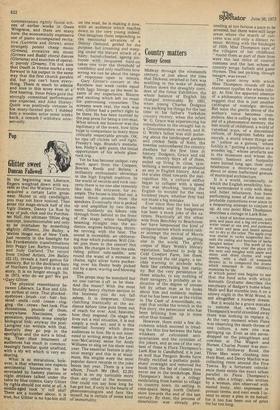Opera
Mann and boy
Rodney Milnes
Boys have suffered various indignities in Britten's stage works. They have fallen over cliffs (Grimes), been shoved half-naked up chimneys and come down — ugh — all sooty (Little Sweep), been hanged (Budd), possessed by ghosts (Screw), enslaved (Curlew River), and represented decadence (Prodigal Son). Now, at last, in Death in Venice, they are loved.
Few works of fiction are so full of pitfalls for operatic adaptation as Mann's internal, superbly controlled novella. Any external dramatic presentation, as we saw in Visconti's film, inevitably tends to coarsen the fable, render it fleshly, mawkish. even. The pitfalls are mostly avoided in Myfanwy Piper's libretto, though not in the act of staging; the symbol of a twelve-year-old boy on the printed page is one thing, and would be something else on stage. But a well-developed nineteenyear-old dancer is quite another, and irrelevant, matter.
The very act of adaptation is tricky. Do you distance yourself from the original, comment upon it from outside and risk brickbats from the literal minded, or do you follow it closely? Britten and Mrs Piper have chosen the latter course, and run a different and perhaps more serious risk. The scenario is enormously detailed and with so many changes of scene as to give even Colin Gra ham insuperable problems in a concert hall with no wing space and no flying. Many stage directions can be only lightly indicated. Narrative has never been opera's strong suit, and the dramaturgical
detail somewhat clouds the central issue, the conflict between Apolline and Dionysiac principles. But it is a masterstroke to follow Mann's hint and give the menacing roles of traveller, painted roué, Charon-like gondolier, hotel manager and barber, entertainer and Dionysus, to a single bassbaritone after the manner of The Tales of Hoffmann. The dominating character of Aschenbach has its foil, and the piece its dramatic shape.
The only serious dramatic flaw is in the two dream sequences. The Dionysiac orgy, Aschenbach's nightmare (much too tamely staged) is balanced, or rather unbalanced, in the first act by Apollo's Feasts of the Sun, celebrating Phoebus, Hyacinth us, Phaedrus, etc; this has less suggestion of ideal dream than of school sports day, and it is followed by an interminable pentathlon for beach boys that is ripe for the chop. The most serious flaw in the presentation at Snape is the choreography by Frederick Ashton, which looks left over from Tales of Beatrix Potter: tittuppy, fussy, with none of the still, mysterious calm that radiates from the book. "It breaks the opera up a bit," said someone in the interval. It breaks it up entirely.
Britten's music, it need hardly be said, is marvellously worked out in dramatic '!..terms, with the strands of plot and the opposing forces of light and dark woven into a convincing whole. Some commentators rightly found echoes of earlier works in Owen Wingrave, and there are many here: the economically expressive use of piano accompanied recitative (Lucretia and Screw), some strangely potent cheap music (Grimes), evocative sea music (Grimes and Budd) choral dances (Gloriana) and snatches of operatic parody (Dream). I'm not sure that Death in Venice marks a step forward in his output in the same way that the first church parable did, but you can't have everything. There is much to admire and love in this score even at a° first hearing. Peter Pe-ars gave the strongly committed performance one expected, and John ShirleyQuirk was positively virtuoso in
• his many-faceted part. I dubbed him a•Wooden actor some weeks back,. a remark I withdraw unreservedly.



































 Previous page
Previous page